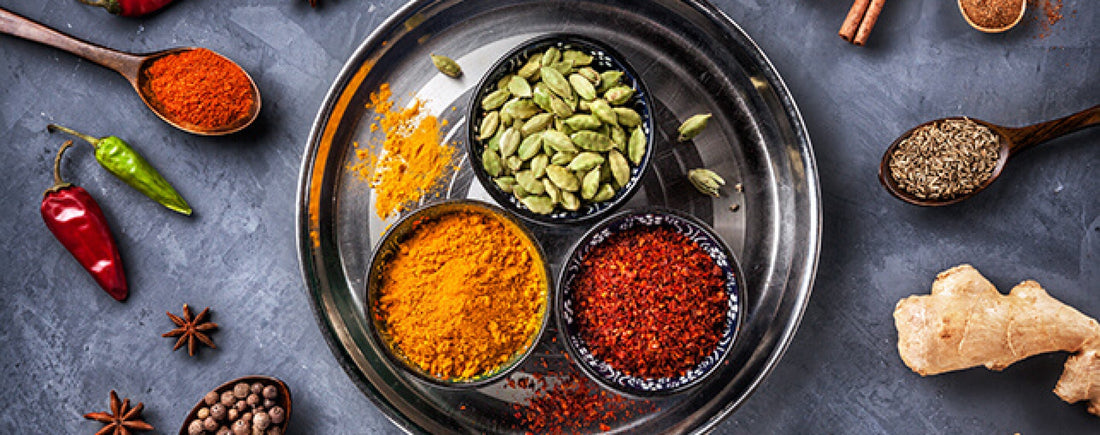In Ayurveda, there are six tastes or Rasas: sweet, sour, salty, bitter, pungent, and astringent. Ayurveda recommends including each of the tastes in every meal. The belief is that incorporating all six tastes in your meals and adjusting the amounts to your personal constitution will help you maintain balanced nutrition and good health, and feel satisfied overall.
Sweet (decreases Vata and Pitta, increases Kapha)
The sweet taste is comprised of water and earth, and is good for balancing Vata and Pitta. Of the six tastes, sweet is known to be the most grounding and nourishing. When eaten in moderation, it promotes longevity, strength, and healthy bodily fluids and tissues.
If you’re trying to gain weight, sweet is the taste to emphasize. Its heavy, oily, and moist attributes slow digestion.
The sweet taste is prominent in foods such as wheat, rice, dairy, cereals, dates, pumpkins, maple syrup, and licorice root.
Sour (decreases Vata, increases Pitta and Kapha)
The sour taste consists of water and fire. It stimulates appetite and saliva production, and is balancing in its light, heating, and oily properties. The sour taste awakens the thoughts and emotions, and can improve appetite, digestion, and elimination. It needs to be eaten in moderation because if you eat it in excess, it can quickly lead to aggression in the body.
Some sour foods are lemon, vinegars, pickled and fermented foods, tamarind, and wine.
Salty (decreases Vata, increases Pitta and Kapha)
The salty taste consists of earth and fire. It’s best for Vata because of its grounding and hydrating nature. Its heat may aggravate Pitta and Kapha. It also adds taste to foods, stimulates digestion, helps electrolyte balance, cleanses tissues, and increases absorption of minerals. However, too much salt can have a negative impact on the blood and skin.
Examples of salty foods are sea vegetables, sea salt, tamari, black olives, Himalayan salt, rock salt, and processed foods that contain salt, although processed foods are not an ideal or recommended source of salt.
Pungent (increases Vata and Pitta, decreases Kapha)
Fire and air make up the pungent taste. Pungent food is the hottest of all the rasas, and therefore stimulates digestion, improves appetite, clears sinuses, stimulates blood circulation, and heightens the senses. Pungent food may help you think quickly and clearly, and understand complicated matters more easily. Too much pungent food, however, can make you overly critical. Pungent foods will aggravate Pitta quickly and balance Kapha. Vata handles pungent tastes best when they are combined with sour, sweet, or salty foods.
Some examples of pungent foods: hot peppers, ginger, onions, garlic, mustard, and hot spices.
Bitter (increases Vata, decreases Pitta and Kapha)
Bitter taste consists of air and space. It’s considered the coolest and lightest of all the tastes. Because of its cool qualities, it’s highly detoxifying and can help remove waste products from the body. Bitter foods also help mental purification by freeing you from passions and sultry emotions. It’s best for Pitta, good for Kapha, and least beneficial for Vata.
Among bitter foods are raw green vegetables, turmeric, and green, black and most herbal teas.
Astringent (increases Vata, decreases Pitta and Kapha)
The astringent taste is made up of air and earth. It’s cool, dry, and firm. Many beans and legumes are astringent and can cause gas, which is why it’s a taste Vata should eat in moderation. Pitta benefits most from astringent taste’s coolness, and its dry, light attributes balance Kapha. Like bitter food, astringent food will help mentally purify and strengthen you.
Unripe bananas, green grapes, pomegranates, cranberries, green beans, alfalfa sprouts, and okra are all astringent foods.
*Editor’s Note: The information in this article is intended for your educational use only and is not a substitute for professional medical advice, diagnosis, or treatment. Always seek the advice of your physician or other qualified health providers with any questions you may have regarding a medical condition and before undertaking any diet, supplement, fitness, or other health programs.
The 6 Rasas
Taste is made from the same five elements that make up the doshas: space, air, fire, water and earth. And each taste has an effect on Vata, Pitta, and Kapha. When your doshas are out of balance, these six tastes can help you repair this imbalance.Sweet (decreases Vata and Pitta, increases Kapha)
The sweet taste is comprised of water and earth, and is good for balancing Vata and Pitta. Of the six tastes, sweet is known to be the most grounding and nourishing. When eaten in moderation, it promotes longevity, strength, and healthy bodily fluids and tissues.
If you’re trying to gain weight, sweet is the taste to emphasize. Its heavy, oily, and moist attributes slow digestion.
The sweet taste is prominent in foods such as wheat, rice, dairy, cereals, dates, pumpkins, maple syrup, and licorice root.
Sour (decreases Vata, increases Pitta and Kapha)
The sour taste consists of water and fire. It stimulates appetite and saliva production, and is balancing in its light, heating, and oily properties. The sour taste awakens the thoughts and emotions, and can improve appetite, digestion, and elimination. It needs to be eaten in moderation because if you eat it in excess, it can quickly lead to aggression in the body.
Some sour foods are lemon, vinegars, pickled and fermented foods, tamarind, and wine.
Salty (decreases Vata, increases Pitta and Kapha)
The salty taste consists of earth and fire. It’s best for Vata because of its grounding and hydrating nature. Its heat may aggravate Pitta and Kapha. It also adds taste to foods, stimulates digestion, helps electrolyte balance, cleanses tissues, and increases absorption of minerals. However, too much salt can have a negative impact on the blood and skin.
Examples of salty foods are sea vegetables, sea salt, tamari, black olives, Himalayan salt, rock salt, and processed foods that contain salt, although processed foods are not an ideal or recommended source of salt.
Pungent (increases Vata and Pitta, decreases Kapha)
Fire and air make up the pungent taste. Pungent food is the hottest of all the rasas, and therefore stimulates digestion, improves appetite, clears sinuses, stimulates blood circulation, and heightens the senses. Pungent food may help you think quickly and clearly, and understand complicated matters more easily. Too much pungent food, however, can make you overly critical. Pungent foods will aggravate Pitta quickly and balance Kapha. Vata handles pungent tastes best when they are combined with sour, sweet, or salty foods.
Some examples of pungent foods: hot peppers, ginger, onions, garlic, mustard, and hot spices.
Bitter (increases Vata, decreases Pitta and Kapha)
Bitter taste consists of air and space. It’s considered the coolest and lightest of all the tastes. Because of its cool qualities, it’s highly detoxifying and can help remove waste products from the body. Bitter foods also help mental purification by freeing you from passions and sultry emotions. It’s best for Pitta, good for Kapha, and least beneficial for Vata.
Among bitter foods are raw green vegetables, turmeric, and green, black and most herbal teas.
Astringent (increases Vata, decreases Pitta and Kapha)
The astringent taste is made up of air and earth. It’s cool, dry, and firm. Many beans and legumes are astringent and can cause gas, which is why it’s a taste Vata should eat in moderation. Pitta benefits most from astringent taste’s coolness, and its dry, light attributes balance Kapha. Like bitter food, astringent food will help mentally purify and strengthen you.
Unripe bananas, green grapes, pomegranates, cranberries, green beans, alfalfa sprouts, and okra are all astringent foods.
*Editor’s Note: The information in this article is intended for your educational use only and is not a substitute for professional medical advice, diagnosis, or treatment. Always seek the advice of your physician or other qualified health providers with any questions you may have regarding a medical condition and before undertaking any diet, supplement, fitness, or other health programs.






















